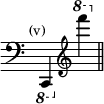4½ octaves existing near Hanover in 1875 had the same—a clue perhaps to its date. Keen and Slade in the time of Queen Anne, used ebony. Dr. Burney writes that the Hitchcocks also had ivory naturals in their spinets, and two of Thomas Hitchcock's still existing have them. But one of John Hitchcock's, dated 1630, said to have belonged to the Princess Amelia, and now owned by Mr. W. Dale, has ebony naturals. All three have a strip of the colour of the naturals inserted in the ivory sharps [App. p.690 "omit the word ivory"], and have 5 octaves compass—from G to G, 61 keys! This wide compass for that time—undoubtedly authentic—may be compared with the widest Ruckers to be mentioned further on.
Under Clavichord we have collected what information is trustworthy of the earliest compass of the keyboards of that instrument. The Italian spinets of the 16th century were nearly always of 4 octaves and a semitone, but divided into F and C instruments with the semitone E or B♮ as the lowest note. But this apparent E or B may from analogy with 'short octave' organs—at that time frequently made—have been tuned C or G, the fourth below the next lowest note.[1] Another question arises whether the F or C thus obtained were not actually of the same absolute pitch (as near as pitch can be practically said to be absolute). We know from Arnold Schlick ('Spiegel der Orgelmacher,' 1511; reprinted in 'Monatshifte für Musik-Geschichte,' Berlin, 1869, p. 103) that F and C organs were made on one measurement or pitch for the lowest pipe, and this may have been carried on in spinets, which would account for the old tradition of their being tuned 'in the fifth or the octave,' meaning that difference in the pitch which would arise from such a system.
The Antwerp (Ruckers) harpsichords appear to have varied arbitrarily in the compass of their keyboards. We have observed E—C 45 notes, C—C 49, B—D 52, C—E 53, C—F 54, G—D or A—E 56, G—E or G—F (without the lowest G♯) 58, F—F 61, and in two of Hans Ruckers (the eldest) F—G 63 notes. In some instances however these keyboards have been extended, even, as has been proved, by the makers themselves.
The English seem to have early preferred a wide compass, as with the Hitchcocks, already referred to. Kirkman and Shudi in the next century, however, in their large harpsichords never went higher than F (q), although the latter, towards the end of his career, about 1770, increased his scale downwards to the C (q). Here Kirkman did not follow him. Zumpe began making square pianos in London, about 1766, with the G—F compass (omitting the lowest G♯)—nearly 5 octaves—but soon adopted the 5 octaves, F—F (r), in which John Broadwood, who reconstructed the square piano, followed him. The advances in compass of Messrs. Broadwood and Sons' pianofortes are as follows. In 1793, to 5½ octaves, F to C (s). In 1796, 6 octaves, C to C (t): this was the compass of Beethoven's Broadwood Grand, 1817. In 1804, 6 octaves F to F (u). In 1811, 6½ octaves, C to F (v). In 1844 the treble G was attained, and in 1852 the treble A. But before this the A—A 7-octave compass had been introduced by other makers, and soon after became general. Even C appears in recent concert grands, and composers have written up to it; also the deepest G, which was, by the way, in Broadwoods' Exhibition grands of 1851. (See w, x, y, z). Many however find a difficulty in distinguishing the highest notes, and at least as many in distinguishing the lowest, so that this extreme compass is beyond accurate perception except to a very few.
 |
 |
 |
 |
 |
 |
 |
The invention of a 'symmetrical' keyboard, by which a uniform fingering for all scales, and a more perfect tuning, may be attained, is due to Mr. Bosanquet, of St. John's College, Oxford, who has had constructed an enharmonic harmonium with one. In 'An Elementary Treatise on Musical Intervals and Temperament' (Macmillan, 1876), he has described this instrument—with passing reference to other new keyboards independently invented by Mr. Poole, and more recently by Mr. Colin Brown. The fingering required for Mr. Bosanquet's keyboard agrees with that usual for the A major scale, and (Ib. p. 20) 'any passage, chord, or combination of any kind, has exactly the same form under the fingers, in whatever key it is played.' Here we have the simplicity of the Double Action harp and undoubtedly a great saving in study. In Mr. Bosanquet's harmonium the number of keys in an octave available for a system proceeding by perfect fifths is 53. But in the seven tiers of his keyboard he has 84, for the purpose of facilitating the playing of a 'round' of keys. It is however pretty well agreed, even by acousticians, that the piano had best remain with thirteen keys in the octave, and with tuning according to 'equal temperament.'
In Germany a recent theory of the keyboard has sought not to disturb either the number of keys or the equal temperament. But an arrangement is proposed, almost identical with the 'sequential keyboard' invented and practically tried in England by Mr. William A. B. Lunn under the name of Arthur Wallbridge in 1843, in which six lower and six upper keys are grouped instead of the historical and customary seven and five in the octave. This gives all the major scales
- ↑ Yet Praetorius distinctly describes the Halberstadt organ, built 1339, re-constructed 1494, as having the lowest note B♮—the scale proceeding by semitones upwards, and we know the sentiment for the leading note had not then been evolved.
